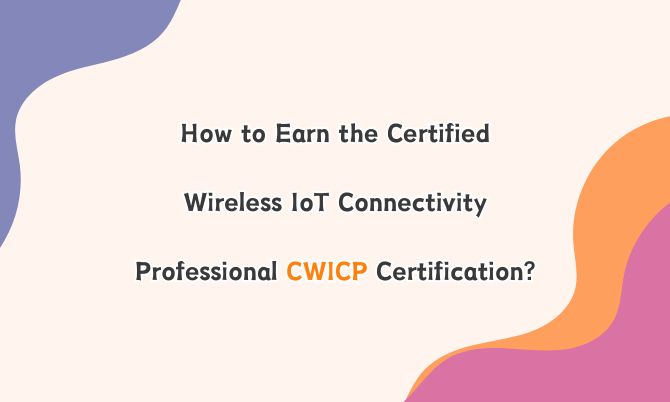The Certified Wireless IoT Connectivity Professional CWICP certification is designed for individuals who want to develop in-depth knowledge and practical expertise in deploying and troubleshooting wireless IoT technologies. As the Internet of Things (IoT) continues to grow, the demand for skilled professionals in wireless IoT connectivity is skyrocketing, and CWICP certification ensures that you have the necessary skills to work with the most common wireless IoT protocols used in business and industrial networks.
1. Prerequisite: Certified Wireless IoT Solutions Administrator (CWISA)
Before you can earn the CWICP, you must first obtain the Certified Wireless IoT Solutions Administrator CWISA certification. The CWISA is foundational and prepares you for the more advanced CWICP by covering various wireless technologies, including:
- Internet of Things (IoT)
- Bluetooth Low Energy (BLE)
- Machine-to-Machine (M2M) communications
- Zigbee, ISA100.11a, WirelessHART, 802.15.4, LoRaWAN, Sigfox, Thread, 6LoWPAN
- Location services
- Wired-side supporting technologies
- High-level awareness of APIs and automation/integration concepts
The CWISA certification ensures you have a broad understanding of wireless networking and prepares you for the specific IoT connectivity solutions covered in CWICP.
2. Study Key Topics in Wireless IoT Connectivity
Once you have your CWISA certification, you can focus on the topics that will help you pass the CWICP exam. Key areas of focus include:
RF Characteristics of IoT Protocols
You need to understand the radio frequency (RF) characteristics of various IoT protocols. This includes their power consumption, range, and behavior under different environmental conditions.
MAC and PHY Layers of IoT Protocols
The Media Access Control (MAC) and Physical Layer (PHY) are essential parts of every wireless IoT protocol. You will learn how these layers operate and how they impact the performance and reliability of IoT networks.
Security Features of Wireless IoT Protocols
Security is critical in IoT networks. CWICP focuses on the security features specific to wireless IoT protocols, ensuring you can identify vulnerabilities and apply appropriate security measures to protect the network.
Troubleshooting Wireless IoT Connections
Knowing how to troubleshoot wireless IoT connections is essential for ensuring network reliability. The CWICP will teach you techniques to diagnose and resolve common issues in IoT deployments.
3. Master Multiple Wireless IoT Protocols
The CWICP exam covers a wide range of wireless IoT protocols, and you'll need to familiarize yourself with each one in detail. Some of the most important protocols include:
- IEEE 802.15.4: The foundation for several IoT protocols, including Zigbee and Thread.
- Zigbee: A widely-used protocol for low-power, short-range communication.
- ISA100.11a and WirelessHART: Used in industrial automation for reliable, secure, and scalable IoT communication.
- LoRaWAN and Sigfox: These protocols are essential for long-range, low-power IoT solutions, often used in agriculture and smart cities.
- Bluetooth: Widely adopted for short-range, low-energy communication between devices.
- Thread: A protocol designed for home automation, providing secure and low-power communication between devices.
- 6LoWPAN: Used for integrating IoT devices with the internet over low-power wireless networks.
4. Practical Experience and Exam Preparation
Practical experience is vital for understanding how wireless IoT solutions operate in real-world scenarios. Engage with hands-on labs, IoT deployments, and troubleshooting exercises to solidify your theoretical knowledge.
You can also prepare by using study materials, practice exams, and study guides available from CWNP (Certified Wireless Network Professional). These materials will give you insights into the exam format, which consists of multiple-choice questions that test your knowledge and problem-solving abilities.
5. Take the CWICP CWICP-202 Exam
After you've completed your study, it's time to take the CWICP CWICP-202 exam. The exam typically consists of:
- Multiple-choice questions that test your understanding of IoT wireless protocols and security.
- Scenario-based questions that assess your ability to troubleshoot and deploy wireless IoT solutions.
Ensure that you understand the key topics listed earlier, as the exam will test your knowledge of RF characteristics, MAC/PHY layers, and troubleshooting techniques across different wireless IoT protocols.
6. Stay Current with Industry Trends
The wireless IoT space is constantly evolving. To maintain your CWICP certification and stay relevant in the field, it’s essential to keep up with the latest advancements in IoT protocols, security standards, and technologies. CWNP offers opportunities for continuing education and recertification to ensure you remain up to date.
The Certified Wireless IoT Connectivity Professional (CWICP) certification is an essential credential for professionals looking to advance in the growing field of wireless IoT. With a solid foundation in wireless networking and IoT-specific knowledge, CWICP-certified professionals are well-equipped to deploy and troubleshoot IoT networks, ensuring secure and reliable connections in business and industrial environments.
